
Hibbertia aspera, commonly known as rough guinea flower, is a species of flowering plant in the family Dilleniaceae and is endemic to eastern Australia. It is an ascending or erect shrub with low-lying or scrambling branches, oblong to lance-shaped or egg-shaped leaves with the narrower end towards the base, and yellow flowers with four to six stamens in a single group, joined at the base.

Hibbertia empetrifolia, commonly known as trailing guinea-flower, is a species of flowering plant in the family Dilleniaceae and is endemic to south-eastern Australia. It is a low-lying to spreading shrub with wiry stems, oblong to lance-shaped leaves with the narrower end towards the base, and pale to bright yellow flowers arranged on the ends of branchlets, with five to nine stamens arranged on one side of the two carpels.

Hibbertia obtusifolia, commonly known as hoary guinea flower, is a species of flowering plant in the family Dilleniaceae and is endemic to south-eastern Australia. It is usually an erect shrub with spreading branches, lance-shaped to egg-shaped leaves with the narrower end towards the base, and yellow flowers with thirty or more stamens arranged around three glabrous carpels.

Hibbertia riparia, commonly known as erect guinea-flower, is a species of flowering plant in the family Dilleniaceae and is endemic to the south-eastern Australia. It is an erect to spreading shrub with hairy foliage, linear leaves and yellow flowers with six to sixteen stamens in a single cluster on one side of two carpels.

Hibbertia hermanniifolia is a species of flowering plant in the family Dilleniaceae and is endemic to eastern Australia. It is an erect shrub with spatula-shaped to wedge-shaped leaves and yellow flowers arranged singly in leaf axils, with ten to fifteen stamens arranged around two hairy carpels.
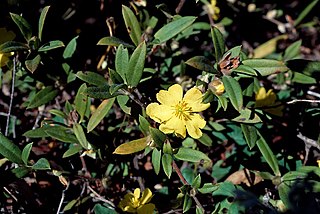
Hibbertia saligna is a species of flowering plant in the family Dilleniaceae and is endemic to the east coast of New South Wales. It is an erect or spreading shrub with narrow elliptic to lance-shaped leaves with the narrower end towards the base and yellow flowers with 20 to 35 stamens arranged around three glabrous carpels.
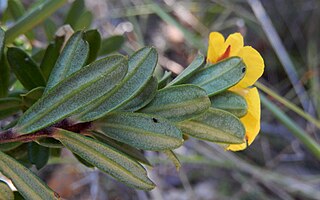
Hibbertia bracteata is a species of flowering plant, in the family Dilleniaceae, and is endemic to eastern New South Wales. It is a shrub with lance-shaped to oblong leaves and yellow flowers with about sixteen stamens arranged on one side of the two carpels.

Hibbertia diffusa, commonly known as wedge guinea flower, is a species of flowering plant in the family Dilleniaceae and is endemic to south-eastern Australia. It is a prostrate to low-lying shrub with glabrous stems, egg-shaped to lance-shaped leaves with the narrower end towards the base, and bright yellow flowers arranged on the ends of branchlets, with twenty to twenty-five stamens arranged around two or three carpels.
Hibbertia banksii is a species of flowering plant in the family Dilleniaceae and is native to Queensland and New Guinea. It is a shrub with thick, leathery leaves and yellow flowers with about twenty to forty-eight stamens arranged on one side of the two carpels.

Hibbertia calycina, commonly known as the lesser guinea flower, is a species of flowering plant in the family Dilleniaceae, and is endemic to south-eastern Australia. It is a small shrub with linear leaves and yellow flowers with eight to eighteen stamens in a single cluster on one side of the two carpels.
Hibbertia cinerea is a species of flowering plant in the family Dilleniaceae and is endemic to the southern part of the Eyre Peninsula in South Australia. It is a densely-branched, hairy shrub with narrow elliptic to lance-shaped leaves, and yellow flowers arranged on the ends of branchlet, with nine to twelve stamens arranged in a group on one side of the two carpels.
Hibbertia cistifolia is a species of flowering plant in the family Dilleniaceae and is endemic to northern Australia. It is a prostrate to low-lying sub-shrub with trailing, wiry stems, hairy foliage, oblong to elliptic leaves and yellow flowers arranged in leaf axils, with forty to fifty-eight stamens arranged around the two carpels.
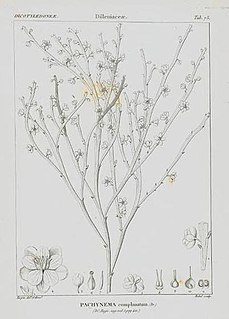
Hibbertia complanata is a species of flowering plant in the family Dilleniaceae and is endemic to the Northern Territory. It is a sub-shrub with two forms of erect, flattened stems, elliptic leaves and pinkish or creamy-white flowers arranged in leaf axils, with seven or eight stamens.
Hibbertia furfuracea is a species of flowering plant in the family Dilleniaceae and is endemic to near-coastal areas of south-western Western Australia. It is an erect shrub with narrow egg-shaped leaves with the narrower end towards the base, and yellow flowers borne in upper leaf axils, with ten to twelve stamens all on one side of two carpels.
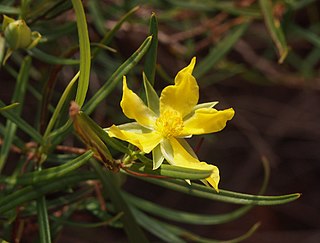
Hibbertia glaberrima is a species of flowering plant in the family Dilleniaceae and is endemic to Central Australia. It is a glabrous, spreading shrub with oblong to lance-shaped leaves and yellow flowers borne singly in upper leaf axils, with 30 to 150 stamens arranged around three carpels.
Hibbertia intermedia is a species of flowering plant in the family Dilleniaceae and is endemic to New South Wales. It is a small shrublet with linear to narrow oblong leaves and yellow flowers usually with seven to nine stamens arranged in a single cluster.

Hibbertia linearis is a species of flowering plant in the family Dilleniaceae and is endemic to eastern Australia. It is a shrub with linear to oblong or egg-shaped leaves and yellow flowers with 15 to 25 stamens arranged around the three carpels.
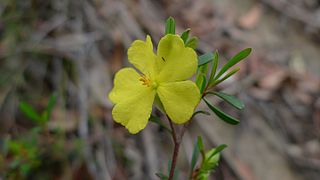
Hibbertia monogyna is a species of flowering plant in the family Dilleniaceae and is endemic to south-eastern Australia. It is an erect, mostly glabrous shrub with linear to wedge-shaped or spatula-shaped leaves and yellow flowers with ten to twelve stamens arranged around a single glabrous carpel.
Hibbertia nitida is a species of flowering plant in the family Dilleniaceae and is endemic to the Central Coast of New South Wales. It is an erect shrub with lance-shaped leaves with the narrower end towards the base and yellow flowers with about eleven stamens arranged on one side of two silky-hairy carpels.

Hibbertia procumbens, commonly known as spreading guinea flower, is a species of flowering plant in the family Dilleniaceae and is endemic to south-eastern Australia. It is a prostrate, often mat-forming shrub with more or less glabrous stems, linear to narrow lance-shaped leaves with the narrower end towards the base, and yellow flowers with eighteen to twenty-five stamens arranged in groups around usually four glabrous carpels.













